Ensuring long-term performance of architectural aluminum finishes
by nithya_caleb | May 23, 2019 12:00 am
by Steven Saffell
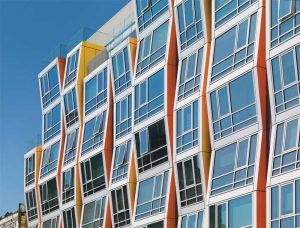 [1]
[1]Aluminum’s strength-to-weight ratio has long established it as the material of choice for many commercial fenestration systems such as curtain wall assemblies and storefronts, and in any type of building exposed to high wind locations like hurricane zones. However, durability is as important an attribute as strength. Given that aluminum is susceptible to corrosion, especially on the seacoast, coatings and finishes assume major importance.
Understanding corrosion
Coastal areas are highly desirable venues for homes, as evidenced by the increase in shoreline population over the recent years, spurring similar commercial development. However, coastal locations feature salt air, encouraging damages and unsightly corrosion of aluminum fenestration framing components.
Coastal sites are not the only corrosion danger zones. Buildings located inland in cold climates may also need protection for aluminum components installed near sidewalks and roads where a large quantity of salt is used for de-icing in the winter. These chemicals can be vaporized into the air by passing vehicles and winds, creating a mist that attack aluminum and its coating when allowed to settle and remain on the surface.
Several forms of corrosion can occur, but the most common one associated with aluminum building components in coastal locations is galvanic corrosion. It occurs when there is contact between two dissimilar metals in the presence of an electrolyte—a water solution conducting an electric current because it contains chemicals, such as chlorines found in salt. The primary variables affecting corrosion rates are the salt content in the air, the length of time metal surfaces are exposed to moisture, air temperature, and the presence of other atmospheric pollutants.
While heavy rains can dilute the electrolyte and provide a washing action to remove harmful deposits, extended dampness—due to small amounts of moisture—can create an aggressive environment when combined with corrosive deposits. Also, corrosion accelerates with increasing temperatures, especially in areas with high humidity.
Additionally, the configuration and machining of the products may also affect corrosion. Machined holes and cut ends form a protective layer of aluminum oxide. This oxide may be susceptible to attack from strong cleaners or heavy salt deposits. Blowing sand can collect in certain joints or seams, eventually eroding the finish. Component shapes may promote the ponding of rainwater. Finally, if weep holes in fenestration framing are not large enough or not properly maintained, they can become plugged by salt deposits.
Filiform corrosion is another form of corrosion particularly affecting coated aluminum. Corrosion will infiltrate the space between the metal and its coating, and slowly expand into fine ‘spider web’ outgrowths, occasionally covering an extensive area and causing severe and unsightly damage. Various factors encourage filiform corrosion, such as irregularities of the coating in the form of small scratches, pockmarks, depressions, and impurities, or cut edges as caused during fabrication of a fenestration unit. Filiform corrosion is aided by increased humidity and the presence of aforementioned salts.
The American Architectural Manufacturers Association (AAMA) is working to meet the demand expressed by some specifiers and architects for a holistic description of what constitutes a corrosive environment and to better address filiform corrosion. It is also researching the viability of referencing the International Organization for Standardization (ISO) 9223, Corrosion of metals and alloys–Corrosivity of atmospheres–Classification, determination and estimation, in the next updated editions of its aluminum finishes standards. ISO 9223 defines six corrosive environments and lists them from very low (C1) to extreme (CX) in their ability to encourage corrosion.
C1 corrosive levels would include heated areas with low humidity and pollutant levels such as offices or museums. The environments continue to increase in severity to Low C2, Medium C3, High C4, Very High C5, and finally Extreme CX. A CX environment would typically have near-permanent condensation levels and high in pollutants. An example of this could be an unventilated chemical storage room for a pool in a tropical environment.
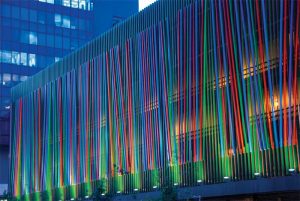 [2]
[2]Photo courtesy Akzo Nobel
Preventing corrosion
As a defensive measure, architectural aluminum should be appropriately coated, consisting of pretreatment followed by a primer and, ultimately, a high-performance fluoropolymer paint or anodized finish. When installed, aluminum components should be isolated from other metals with nonabsorbent, nonconductive polymer sleeves and washers.
Pretreatment
As the most crucial first line of defense against paint failure on aluminum, pretreatment determines the durability and longevity of the end product. This involves the removal of dust, grease, and any other foreign particles using chemical and mechanical methods, ensuring the surface is clean for enhanced coating adhesion and to prevent flaking.
Perhaps the most effective pretreatment for aluminum architectural products is a chrome phosphate conversion coating. It is highly corrosion-resistant and provides excellent coating adhesion. Application of these coatings conforms to Type B, Method 5 of ASTM D1730-09 (reapproved 2014), Standard Practices for Preparation of Aluminum and Aluminum-Alloy Surfaces for Painting. To meet the most rigorous industry specifications, a commonly used 70-percent polyvinylidene fluoride (PVDF) coating is subject to rigorous performance testing, including more than 4000 hours of salt spray exposure, and heat-and humidity-resistance requirements.
The typical process for chrome phosphate pretreatment involves subjecting the part to a multistage immersion or spraying process. The first stage cleans the aluminum to remove soils, oils, and grease, as well as metal oxides. Stage two is a clean-water rinse. This is followed by the application of an amorphous chromium phosphate coating, applied in a uniform coating greater than 40 mg per 0.093 m2 (0.0014 oz per sf) according to ASTM B449, Standard Practice for Chromate Treatments on Aluminum. Stages four and five focus on rinsing. Types of pretreatment processes other than chrome phosphate are:
- polymer with zirconium and titanium (dried-in-place [DIP]);
- polymer with zirconium and low fluoride (DIP);
- polymer with zirconium and high fluoride (DIP);
- high zirconium and low titanium (rinsable);
- low zirconium and high titanium (rinsable);
- zirconium, titanium, and silane (rinsable); and
- silane only (rinsable).
Coatings
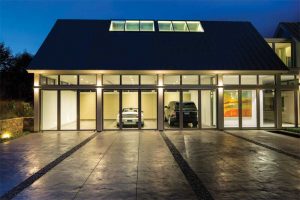 [3]
[3]Photo courtesy Wasco
Externally applied coatings can be in the form of organic (hydrocarbon-based) paints, such as acrylics, fluoropolymers, polyesters, and siliconized polyesters. Each coating contains pigments and resins, or binders, which are the primary basis for their classification. In addition to the wide range of color choices, including bright metallic hues, paint finishes provide an attractive, smooth appearance. These organic coatings can be applied in a number of ways. Some of the more common methods include a spray system, similar to the way a car would be painted:
- dipping, that generally requires large automated conveyers; and
- tanks filled with the finish material of choice or powder coating.
AAMA standards describe laboratory test methods and performance criteria shown to be critical to coating performance. They are organized in a sequential order of basic-, high-, and superior-performance (i.e. ‘good, better, and best’)—a triumvirate of increasingly stringent performance criteria. This hierarchy allows architects to choose the best and most cost-effective match for the type and location of building and weather exposure. For aluminum profiles, the standards for organic coatings:
- AAMA 2603-17a, Voluntary Specification, Performance Requirements and Test Procedures for Pigmented Organic Coatings on Aluminum Extrusions and Panels (with Coil Coating Appendix);
- 2604-17, Voluntary Specification, Performance Requirements and Test Procedures for High Performance Organic Coatings on Aluminum Extrusions and Panels(with Coil Coating Appendix); and
- 2605-17a, Voluntary Specification, Performance Requirements and Test Procedures for Superior Performing Organic Coatings on Aluminum Extrusions and Panels (with Coil Coating Appendix).
The entry requirement for finish compliant with AAMA 2603-17a must be 20 µm (0.8 mils) thick, while those meeting 2604-17 and 2605-17a, must be 30 µm (1.2 mil) thick. The highest-performing coating would meet AAMA 2605-17a.
All three standards test for color uniformity, specular gloss, dry film hardness, film adhesion, resistance to impact, chemical, corrosion (caused by humidity and salt spray), and color fading or deterioration due to weathering. AAMA 2604-17 and 2605-17a, add abrasion resistance to this list. For other factors, exposure conditions vary. For example, exposure time to the corrosive influences of high humidity increases across 2603-17a, 2604-17, and 2605-17a, from 1500 to 3000 and 4000 hours, respectively. Weathering test duration also increases from one and five to 10 years, respectively. Corrosion susceptibility based on reaction to salt spray testing varies among the standards as well.
These are the specific requirements for superior performing coatings as described in AAMA 2605-17a.
Humidity
 [4]
[4]Photo courtesy YKK AP America
The sample is exposed in a controlled heat and humidity cabinet for more than 4000 hours at 38 C (100 F) and 100 percent relative humidity (RH). No formation of blisters to the extent greater than ‘few’ blisters, as defined by ASTM D714-02 (2017), Standard Test Method for Evaluating Degree of Blistering of Paints. Cyclic corrosion testing (previously referred to as salt spray resistance).
Score the film deep enough to expose the base metal. Expose the sample for 2000 hours according to the dilute electrolyte cyclic fog/dry test in Annex A5 of ASTM G85, Standard Practice for Modified Salt Spray (Fog) Testing. The sample must score a minimum rating of 7 on scribed or cut edges, and a minimum blister rating of 8 within the test specimen field, as defined in ASTM 1654, South Florida exposure.
South Florida exposure
The coating shall maintain its film integrity, color and gloss retention, and chalk- and erosion-resistance properties for a minimum of 10 years on the South Florida on-fence testing site.
Color retention
Maximum of 5ΔE Units (Hunter) of color change after the minimum 10-year exposure test. A ΔE unit is the variance or color difference measured on a vector scale from a specific point in the color space.
Chalk resistance
Chalking shall be no more than represented by a No. 8 rating for colors and No. 6 for whites after 10 years of test-fence exposure. Per ASTM D4214-07 (2015), Standard Test Methods for Evaluating the Degree of Chalking of Exterior Paint Films, chalking is measured on a numerical scale with higher numbers representing better chalk resistance.
Gloss retention
Gloss retention shall be a minimum of 50 percent after the 10-year exposure testing, as described by ASTM D523-14 (2018), Standard Test Method for Specular Gloss.
Resistance to erosion
Less than 10 percent film loss after the 10-year exposure testing. AAMA notes in high-humidity environments such as, but not limited to, coastal or industrial areas, performance of corrosion resistance may be diminished.
Sand abrasion testing improvements
An appropriate test to determine the abrasion resistance of organic coatings has been a falling sand test (ASTM D968, Standard Test Methods for Abrasion Resistance of Organic Coatings by Falling Abrasive), referenced in AAMA 2604-17 and 2605-17a, intended to simulate the effect of wind-driven sand. This test is still in high demand in the Middle East as well as in beach and desert environments in the United States. However, research has revealed there is a lot of variation between labs in the results, and it does not appear to have the repeatability and precision to provide good data.
Accordingly, the abrasion test in 2604-17 and 2605-17a will be changed in future to show the requisite performance mandate as ‘calculate and report’ versus the current pass/fail requirement prescribing a minimum passing value. Additionally, AAMA 2604-17 and 2605-17a abrasion resistance sections will match the corresponding sections in AAMA 624-17a, Voluntary Specification, Performance Requirements and Test Procedures for High Performance Organic Coatings on Fiber Reinforced Thermoset Profiles, and 625-17a, Voluntary Specification, Performance Requirements and Test Procedures for Superior Performance Organic Coatings on Fiber Reinforced Thermoset Profiles, standards for fiberglass finishes.
Corrosion testing evolves
AAMA has been conducting testing to evaluate alternatives for the use of salt spray fog to more accurately quantify corrosion. The likely outcome will be the replacement of ASTM B117-18, Standard Practice for Operating Salt Spray (Fog) Apparatus test, with ASTM G85-11, Standard Practice for Modified Salt Spray (Fog) Testing, method in AAMA 2604-17, as in AAMA 2605-17a.
The current corrosion performance test specified in AAMA 2603-17a and 2604-17 is ASTM B117-18, providing a controlled corrosive environment to produce relative corrosion-resistance information. However, correlation and extrapolation of actual corrosion performance has not always been predictable.
The ASTM G85-11 is described as useful when a different or more corrosive environment than the salt fog described in B117-18 is desired. Conditions for five modifications in salt spray (fog) testing are set forth in the form of annexes. For use with architectural aluminum, the cyclic acidified salt spray test in Annex A5 will be specified.
The cyclic corrosion testing method described in ASTM G85 is effective for evaluating a variety of corrosion mechanisms, including general, galvanic, and crevice corrosion. It is a more realistic way to simulate observed outdoor conditions than traditional steady state exposure tests, such as B117-18. Since actual atmospheric exposures usually include both wet and dry conditions, by using cyclic corrosion testing accelerated laboratory tests can be patterned after these natural cyclic conditions.
Powder coating finishes
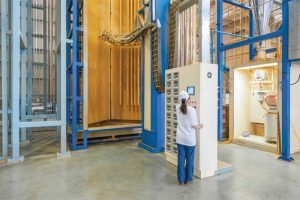 [5]
[5]Photos courtesy AAMA
Powder coating is usually considered one of the most favored, durable, and cost-effective alternative among finishing options for aluminum extrusion products. It increases protection from cold, heat, corrosion, scratching, or even bleaching under the hot sun. Specific advantages include:
- the coating is fusion bonded to form a thicker coating, providing better protection and longer product life;
- since there are no solvents used, no potentially carcinogenic volatile organic compounds (VOCs) are released into the atmosphere, which many consider to make the process more environmentally friendly than liquid finishing; and
- the powder coating processes require significantly less energy for production.
Powder coating finishes involve a systematic process that— after pretreatment— consists of two steps.
Application
The powder, a fine mixture of colored pigment and resin, is commonly applied with an electrostatic spray gun. The powder is given a positive charge causing it to bond to the electrically grounded surface of the product. Other powder coating methods are fluidized bed, electrostatic magnetic brush, and electrostatic discs methods.
Curing
The object is heated in an oven for a set duration at a fixed temperature, causing the powder to melt uniformly, thus forming a hard coating when cooled.
Powder coating finishes on aluminum extrusion products can be categorized into thermosets and thermoplastics. The polymers used most commonly are acrylics, polyester, epoxy, and the hybrid polyester-epoxy.
Anodic finishes
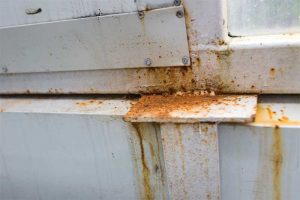 [6]
[6]Since it is an integral part of the substrate, the oxide film produced by the anodizing process is uniform, hard, and protects the rest of the aluminum substrate from wear and abrasion. The coating is extremely durable, with the hardness of the surface comparable to a sapphire, the second hardest substance on earth next to diamond. This characteristic makes anodizing a suitable choice for use in high-traffic areas where resistance properties are important.
The process passes a direct electric current between aluminum and the electrolyte, with the alloy acting as the anode. The procedure mimics the naturally formed oxide film, but results in a thicker, more controlled formation of a durable oxide film.
To ensure quality and durability under long-term outdoor exposure, AAMA 611-14, Voluntary Specification for Anodized Architectural Aluminum, requires the anodized finish to pass tests for color and gloss uniformity, abrasion, corrosion, and resistance to ‘crazing’ (the formation of a network of fine cracks). It must also pass a weathering test, requiring minimal color fading or chalking (formation of a white film) due to sunlight after up to 10 years of exposure (depending on the specified performance level) in a Florida test location.
It is pertinent to note, the natural beauty of an anodic finish can be marred by harsh chemicals, rough conditions, or neglect. These conditions may only affect the surface finish and not reduce the service life of the aluminum, but mortar, cement, and other alkaline materials will quickly corrode an anodic finish if allowed to dry on the metal surface.
While similar to the requirements of the 2600 series of AAMA documents for organic finishes, the AAMA 611-14 and 612-17a, Voluntary Specification, Performance Requirements, and Test Procedures for Combined Coatings of Anodic Oxide and Transparent Organic Coatings on Architectural Aluminum, documents cover the unique requirements expected of anodic finishes. In order to meet AAMA 611-14 requirements, a Class I anodized finish must pass these stringent guidelines.
Abrasion resistance (Michael Clarke Test)
A go/no-go abrasion test using abrasive papers coated with silicon carbide, garnet, and glass, respectively.
Corrosion resistance testing
Expose the sample for 3000 hours according to ASTM B117-18 using a five percent salt solution. Test samples shall show no more than a total of 15 isolated spots or pits, none larger than 1 mm (39 mils) in diameter, in a total of 3810 mm (150 in.) of test area grouped from five or more test pieces.
South Florida exposure
The coating shall maintain its color and gloss retention and erosion-resistance properties for a minimum of 10 years on the south Florida on-fence testing site.
Color retention
Maximum of 5ΔE Units (Hunter) of color change after the minimum 10-year exposure test.
Gloss retention
Gloss uniformity shall be within established gloss range.
AAMA 611 defines two levels of quality. The highest, Class I, designates ‘high performance’ finishes at least 18 µm (0.7 mils) thick and are used in exterior applications receiving periodic maintenance, such as curtain walls. The second level, Class II, encompasses finishes between 10 µm (0.4 mils) and 18 µm thick used in interior or exterior applications receiving regularly scheduled cleaning and maintenance, such as storefronts.
A related standard, AAMA 612-17a, describes test procedures and performance requirements for anodized finishes combined with transparent organic coatings.
Solar reflectivity enhances energy efficiency
Another supplement to the AAMA 2603-17a/2604-17/2605-17a series, AAMA 643-16, Voluntary Specification, Performance Requirements and Test Procedures for Solar Reflective Finishes, describes a solar reflectance test per ASTM C1549-16, Standard Test Method for Determination of Solar Reflectance Near Ambient Temperature Using a Portable Solar Reflectometer, procedures and performance requirements for pigmented, organic, solar reflective coatings keeping the coated surfaces cooler than they would be with standard coatings. It applies to coatings for aluminum, as well as fiberglass or cellulosic-composite profiles particularly reflective to sunlight, and so tend to keep buildings cooler. This is a boon to commercial buildings, that are cooling-intensive and do not require much heating.
Using AAMA[7] finish standards as a guide, specifiers can select a painted coating or anodized finish to meet a project’s performance and long-term durability targets based on the building’s location and function, the desired aesthetic appearance, and the aluminum products’ proximity to dissimilar metals.
Steven Saffell serves as American Architectural Manufacturers Association’s (AAMA’s) technical director where he oversees the standards, product certification and codes, and regulatory affairs aspects of the association. Saffell’s background is a tapestry of architectural firm work, modular design, as well as residential and commercial fenestration experience. Saffell also spent three years teaching as an adjunct professor. He is experienced in managing technical teams, including employee development, operational strategy, and financial management. With 32 years of experience, Saffell previously worked with Simonton Windows and Ply Gem. He can be reached at ssaffell@aamanet.org[8].
- [Image]: https://www.constructionspecifier.com/wp-content/uploads/2019/05/CA-Vida_RienVanRijthoven-Winco1.jpg
- [Image]: https://www.constructionspecifier.com/wp-content/uploads/2019/05/Public-art-Akzo-Nobel.jpg
- [Image]: https://www.constructionspecifier.com/wp-content/uploads/2019/05/Garage-Wasco.jpg
- [Image]: https://www.constructionspecifier.com/wp-content/uploads/2019/05/Findlay-Market-Cincinnati-YKK-AP.jpg
- [Image]: https://www.constructionspecifier.com/wp-content/uploads/2019/05/Powder-coating-application-no-photo-credit.jpg
- [Image]: https://www.constructionspecifier.com/wp-content/uploads/2019/05/Corrosion-no-photo-credit.jpg
- AAMA: http://www.aamanet.org/store
- ssaffell@aamanet.org: mailto:ssaffell@aamanet.org
Source URL: https://www.constructionspecifier.com/ensuring-long-term-performance-of-architectural-aluminum-finishes/